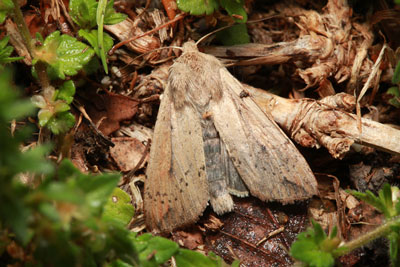Question of the Week Number 1: October 11, 2018
“What are all these moths I’ve been seeing? Are they from the armyworms?”
I don’t always encounter every problem and every question that gardeners pose to me, but in this case, I certainly have. We drove in our driveway three evenings ago and a blizzard of little tan moths greeted us. I’ve honestly never seen anything like it.

Photo (from Texas A&M): If you’re seeing dozens of these little tan moths flittering about, there’s a chance you’ll be seeing armyworms in a couple of weeks. Read on.
The Garden Tip I posted on Facebook a few nights ago quickly was viewed by more than any other post I’ve made all year. From the hundreds of comments, it’s obvious the moths have been swarming all over the eastern half of our state.
So that gave me reason to warn my Facebook friends to be on the lookout for another generation of armyworms in the next couple of weeks just in case they might develop. They’re the larval form of this little moth. You may remember from one month ago how the worms stripped bermudagrass lawns bare leaving browned stubble in just one or two days. They may be coming back.
Remember: the moths don’t do any harm, so you don’t need to worry about spraying them. But the armyworms, should they reappear, can quickly devour bermuda turf. They generally don’t prefer St. Augustine and other types of lawngrasses, but if bermuda isn’t available they’ll eat just about anything. And as we discovered a month ago, most general-purpose insecticides have armyworms on their labels. The bigger problem came in finding a source. Most stores were sold out of insecticides entirely.

This is what an armyworm looks like as it feeds on turfgrass. (Photo from Texas A&M)
Dr. Mike Merchant checked in to help…
We are lucky to have fine scientists working within the Texas A&M System to help us, and urban entomologist Dr. Mike Merchant with Texas AgriLife Extension is one of the best.
He emailed me a couple of days ago to say that he had sampled moths he found flying and felt that most, if not all, were fall armyworm moths. He added he wouldn’t be surprised to find several other types around.
Dr. Merchant feels that cooler temperatures we are experiencing may slow down the life cycles of the caterpillars. He says it’s debatable whether there will be another generation of armyworms, but he advises us all to be vigilant as we watch for signs of renewed feeding.
As before, I offer the Extension publication of which Dr. Merchant was one of the authors. This will provide you all the pertinent information you will need.
